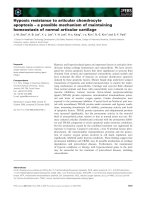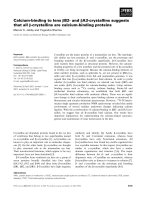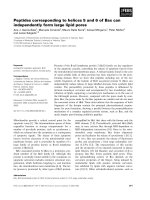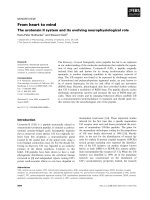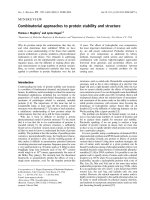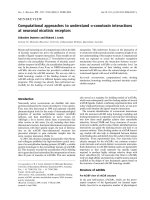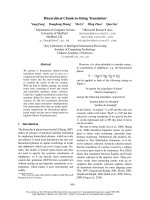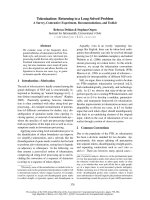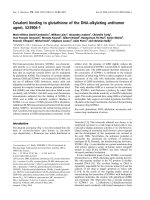Báo cáo khoa học: "Lexical Semantics to Disambiguate Polysemous Phenomena of Japanese Adnominal Constituents" potx
Bạn đang xem bản rút gọn của tài liệu. Xem và tải ngay bản đầy đủ của tài liệu tại đây (664.18 KB, 8 trang )
Lexical Semantics to Disambiguate Polysemous Phenomena of
Japanese Adnominal Constituents
Hitoshi Isahara
and Kyoko Kanzaki
Communications Research Laboratory
588-2 Iwaoka, Iwaoka-cho, Nishi-ku
Kobe, Hyogo, 651-2401, Japan
{isahara, kanzaki}~crl.go.jp
Abstract
We exploit and extend the Generative Lexicon The-
ory to develop a formal description of adnominal
constituents in a lexicon which can deal with linguis-
tic phenomena found in Japanese adnominal con-
stituents. We classify the problematic behavior into
"static disambiguation" and "dynamic disambigua-
tion" tasks. Static disambiguation can be done using
lexical information in a dictionary, whereas dynamic
disambiguation requires inferences at the knowledge
representation level.
1 Introduction
Natural language processing must disambiguate pol-
ysemous constituents in
the input
sentences. A good
description of information necessary for disambigua-
tion in the lexicon is crucial in high quality NLP sys-
tems. This paper discusses the treatment of linguis-
tic phenomena in Japanese adnominM constituents
and it focuses on how to generate the same semantic
representation from different syntactic structures,
and how to generate different semantic representa-
tions from a semantically ambiguous sentence. We
exploit and extend the Generative Lexicon Theory
(Pustejovsky, 1995; Bouillon, 1996) to develop a for-
mal description of adnominal constituents in a lexi-
con which can offer a solution to these problems.
We classify the problematic behavior of Japanese
adnominal constituents into "static disambiguation"
and "dynamic disambiguation" tasks. Whereas
static disambiguation can be done using the lexical
information in a dictionary, dynamic disambigua-
tion needs inferences at the knowledge representa-
tion level. This paper mainly discusses dynamic dis-
ambiguation.
2 Classification of the Usage of
Japanese Adnominal Constituents
On consideration of the syntactic relations between
adnominal constituents and their head nouns, we
find that some adnominal constituents can appear
both in the attributive and predicative positions
(Sakuma, 1967; Martin, 1975; Makino and Tsutsui,
1986). However, some adjectives express different
meanings when they appear in one or the other po-
sition and some adjectives can appear only in one of
these two positions (Hashimoto and Aoyama, 1992).
We have classified the semantic relations between
adnominal constituents and their modified nouns,
based on whether the paraphrasing from attributive
position to predicative position is possible or not.
There are three possibilities:
(Type A)A paraphrase can be made without
changing the modifying relations semantically.
Ad. + N -, N $~
(ga)
Ad. (N is Ad.)
Ad. = Adnominal constituent
N = Head noun of noun phrase which
is modified by Ad.
(Type B) A paraphrase can be made only when a
noun is restricted by its context: the presence
of modifiers or determiners, e.g., articles.
Ad. + N * ~:¢)(sono)
N F~ (wa)
Ad.
(that N is Ad.)
(Type C) A paraphrase cannot be made at all, i.e.,
only the attributive position is available.
Ad. + N ~ *none.
We can classify semantic relations between ad-
nominal constituents and their head nouns into three
types by the use of paraphrase. Paraphrases exist for
both Type A and Type B, however, a paraphrase
cannot be made at all for Type C. This difference
is based on the fact that adnominal constituents in
types A and B modify the referents of their mod-
ified nouns, while adnominal constituents in Type
C do not modify their head nouns directly. Type
C adnominal constituents modify (a) only a part of
the meanings which their modified nouns allow, (b)
the contents of the referents of their modified nouns,
or (c) the states of being of the referents of their
modified nouns. In this paper, we do not describe
the
semantic relations of (b) in detail but discuss
489
the semantic relations of (a) and (c) in the following
section.
There is a set of adnominal constituents which
has the function of both adnominal and adverbial
constituents (Teramura, 1991), and the third re-
lation (c) above is the adverbial semantic relation
which holds between adnominal constituents and
their head nouns.
3 Classification of Problematic
Behavior of Japanese Adnominal
Constituents
It is important for the analysis of adjectives to con-
sider what its head noun denotes in the sentence
(Bouillon, 1996). Also, when we analyze word mean-
ings, it is important to take both context and our
world knowledge into account (Pustejovsky, 1995;
Lascarides and Copestake, 1998). In this section,
the behavior of Japanese adnominal constituents is
classified into three types, depending on how the se-
mantic representation of noun phrases is generated
from information in the lexicon (Kanzaki and Isa-
hara, 1997; Kanzaki and Isahara, 1998).
The types are: (1) the type where one must infer
the attribute of the modified noun which is expressed
by the adnominal constituent, (2) the type which
necessitates inferences that change the structures of
the
semantic representation, and (3) the type whose
adnominal constituents do not add information to
the modified nouns but constrain the relations be-
tween constituents in the text. These types are ex-
plained in this section. Both semantic types A and
B correspond to syntactic types 1 and 2. Type C
corresponds to type 3.
3.1
Adnominal Constituents that
Express
the Attributes of the Modified Noun
[Static disambiguation]
This is the case where an adnominal constituent
modifies a head noun semantically. Adnominal con-
stituents modify nominals syntactically and most of
these modify their head nouns semantically. Here,
the "analysis" of the relationship between adnomi-
nal constituents and their head nouns concerns the
choice of the particular attribute of the nouns which
adnominal constituents modify. There are two types
of inferences for disambiguation.
3.1.1
Adnominal Constituents that
Express
Unique Inherent Attributes of the
Modified Noun
This is the case in which the relation between the
adnominM constituent and its modified noun, i.e.,
what slot of the modified noun the modifier fills, can
be predicted.
In Example 1,
F@$~P~Tk (yuruyaka_na,
gen-
tle)_l is the attribute value of an instance of the
concept I-~ t
(keisha,
slope)J . The instance [-{~
~r (keisha,
slope)J involves a unique inherent at-
tribute, i.e., "the angle (degree) of the slope," there-
fore
r@~-~,~ (yuruyaka_na,
gentle)J is taken
to be a value on the scale of the slope. The noun in
this example has a unique inherent attribute whose
value is number or intensity.
Example 1
yuruyaka_na keisha ,
gentle slope
Japanese pronunciation
literal translation
3.1.2
KEISHA (slope) YURUYAKA_NA (gentle)
]degree I
Adnominal Constituents that
Express
One of the Major Attributes of the
Modified Noun
This is the case in which the NLP system must iden-
tify the slot of the modified noun which is filled by
the modifier. Most nouns do not have a unique
inherent attribute but have several attributes that
adnominal constituents may embody. In Example
2, [-:~1
(otoko,
man)J has several major attributes,
e.g., name, age, character, and physique. An un-
derstanding system must choose a suitable attribute
(i.e., physique in this example) to plug information
in from these attributes.
Example 2
oogara_na
large
otoko
man
OTOKO (man) ~,~
age
[ I"- OOGARA_NA (large)
name I ' ~._1"
physique/ vJ ,
character ~ [ ]
These types of adjectives can appear both in the
predicative position and in the attributive position
without changing their meanings (Sakuma, 1967;
Teramura, 1991; Hashimoto and Aoyama, 1992).
r:gk:~: (oogara_na,
large)J in Example 2 can ap-
pear in predicative position, i.e., I-~:¢)~IJ~Jk:~
(sono otoko wa oogara_da,
that man is large)_l , with
the same meaning that the man has a big physique.
We cannot decide on one particular attribute of
the head noun without suitable semantic informa-
tion. Also, still another problem remains here, that
490
is to identify whether the sentence needs a generic
reading or whether it represents an instance of the
concept.
3.2 Adnominal Constituents that Express
Attributes of the Situation Inferred
from the Modified Noun [Dynamic
disambiguation 1]
In some cases, adnominal constituents do not modify
instances of nouns themselves, but modify, instead,
instances of events, situations, or knowledge that are
inferred from (the context of) the modified noun.
3.2.1 The Case in which New Elements
must
be Infered in the Semantic
Representation
There are cases in which we have to infer new ele-
ments in the semantic representation so as to rep-
resent semantic relations between adnominal con-
stituents and their modified nouns.
In Example 3, the adjective modifies some event
participated in by the household members. A house
cannot have a temporal scale as an attribute, how-
ever, an event, in this example, spring-cleaning, can
be inferred from the context and therefore the ad-
jective F~w
(hayai,
early)J can modify the event,
e.g., the beginning time of spring-cleaning.
However, its computational implementation is not
so simple, because there are metonymic extensions
going on in this example. For example, even if an
NLP system can find "spring-cleaning" in the con-
text as an event whose "begining-time" is "early,"
the system must infer the people living there from
"house" and identify him/her as an agent of the
spring-cleaning.
Some of these inferences are done using syntactic
structure in English, however , that is not possible in
Japanese. Such metonymic extensions are essential
for determining the nature of the modifier/modified
relationships in Japanese (Matsumoto, 1993).
Example 3
(oosoji_no) hayai ie
(spring-cleaning) early house
"The house whose member begins spring-cleaning
early."
OOSOJI HAYAI (early)
(spring-cleanin~) , [
I beginning-time ~
- II 'HITO( on)
IE (house)
I
]member ] 1
3.2.2 The Case in which a
Concept must
be Converted into a Set of Concepts
Adnominal constituents sometimes do not modify
nouns as a whole but modify only specific features of
a noun. Example 4 is ambiguous. The "as a whole"
interpretation is that this person likes something and
he/she is abnormal as a whole, i.e., this person has
some mental disorder. The "specific" interpretation
is that this person likes something abnormally, i.e.,
the way this person likes something is abnormal, i.e.,
this person is crazy about something x. Ambiguities
of ['~,~
(ijo_na,
abnormal)_l in Example 4 will
be discussed systematically below.
Example 4
ijo_na sensei-jutsu_no aikosha
abnormal astrology enthusiast, one who
likes something very
much
As a whole
interpretation
IJO AIKOSHA SENSEI-JUTSU
abnormal) (enthusiast) (astrology)
I
Specific interpretation
IJO AIKO-SURU SENSEI-JUTSU
(abnormal) (like) (astrology)
object
object ~ [
To treat the "specific" interpretation, the system
has to perform the concept conversion (Isahara and
Uchida, 1995) shown in Figure 1.
As for the "as a whole" interpretation, an adnomi-
nal constituent modifies an extension of the modifiee
(e.g., what is abnormal is a person who is an astrol-
ogy enthusiast). Therefore, the object slot of (an
instance of) "abnormal" is filled by (an instance of)
"enthusiast." In the "specific" interpretation, how-
ever, an adnominal constituent modifies part of the
intensions to which the modifiee refers (e.g., what is
abnormal is the way that person likes something).
An analysis module converts the semantic structure
(Figure 1) and the object slot of (an instance of)
"abnormal" is filled by (an instance of) "like" which
is extracted by the concept conversion.
1There is one more interpretation that "an enthusiast who
likes abnormal astrology," however, this interpretation is odd
in this example.
491
AIKOSHA
(enthusiast) something
Concept
Conversion
AIKO-SURU
like) something
object~ 'l
agent [-] [ ]
~HITO (perTn)
"enthusiast" J
Figure 1: Concept Conversion
The concept conversion is, in a sense, a paraphrase
of the original expression. The concept conversion
is also useful in analyzing Example 5.
Example 5
sensei-jutsu_no ijo_na aikosha
astrology abnormal enthusiast
Example 5 is not ambiguous, i.e., the only inter-
pretation is % person who likes astrology abnor-
mally," because the "as a whole" interpretation is
not possible. Example 5 can be paraphrased into
the phrase shown in Example 6. If
I-~
(sensei-
jutsu, astrology)A is semantically an object of r~
~-"f B (aiko_suru, like)A,
r~$~c
(ijo_ni, abnor-
mally)2 cannot modify r~ (mono, person)J , be-
cause the dependencies in this interpretation cross
each other.
Example 6
sensei-julsu_wo ijo_ni aiko_suru mono
astrology abnormally like person
Example 7 exhibits the adnominal constituent
F~?~
(ijo, abnormal)J in a predicative position.
Using the extension of the Late Closure strategy
(Frazier, 1979), only the "as a whole" interpretation
is possible.
Example 7
aikosha_ga ijo_da
enthusiast abnormal
"The enthusiast is abnormal."
3.3 Adnominal Constituents that Constrain
the Relations between Constituents in
the Text [Dynamic disambiguation 2]
3.3.1 Adnominal Constituents that do not
Add Information to their Modified
Nouns Directly
Adnominal constituents mostly modify nouns syn-
tactically and also semantically. However, some
adnominal constituents work differently, i.e., they
modify nouns syntactically but not semantically.
Japanese nominal adjectivals
F~:
(junsui_na,
pure)A, F~.~::~: (kanzen_na, perfect/complete).]
and [-:~ < (mattaku, entire).] are typical examples
of this type.
1-i~4~ (junsui_na, pure)A in Examples 8-10 and
[-~.~: (kanzen_na, complete)_l in Examples 11-13
play different semantic roles.
Example 8
junsui_na
pure
"pure water"
Example 9
t~at
ekkyo_wa
border
transgression
mizu
water
junsui_na seiji_bomei datta.
pure political (copula,
flight past)
"The border transgression was a pure political
flight."
Example 10
junsui_na churitsu_wa mutsukashii.
pure/strict neutrality difficult
"Strict neutrality is difficult."
Example 11
kanzen_na shisutemu dewa nai.
complete system (copula) (negation)
"This is not a complete (perfect) system."
Example 12
nousakumotsu_wa kanzen_na syohizai dearu.
farm products complete consumer (copula)
products
"Farm products are nothing but consumer
products."
Example 13
kanzen_na mujin_no yakala
complete uninhabited house
"absolutely uninhabited house"
492
In Example 8,
Fi~
(junsuLna,
pure)J de-
scribes the purity of water, i.e., it describes some-
thing within the "water" concept. The adnominal
constituent I-gk:~Tz
(oogara_na,
large)J , in Exam-
ple 2, expresses a value of an attribute of the modi-
fiednoun, i.e., [-~
(oloko,
man)J . In contrast, the
adnominal constituent [-~
(junsui_na,
pure)J ,
in Example 8, does not express a value of an at-
tribute of the modified noun, i.e.,
FT]( (raizu,
wa-
ter)] , but expresses the way some values fill at-
tributes of this modified noun. That is "nothing but
water is a filler of an attribute of the referent." In
Example 11,
F-~_/k (kanzen_na,
complete)] de-
scribes the completeness of a system as well, i.e.,
it describes something within the "system" concept,
e.g., the function of the system. (Case 1)
In Example 9, Fi~
(junsuLna,
pure).l does
not add information as to the purity of this polit-
ical flight, however, it describes that there is only
one purpose (or motivation), i.e., political flight, for
this "border transgression." In other words, there is
no other motivation, such as sightseeing or economic
reasons, which would explain this action. {-~,~:
(junsui_na,
pure)J describes something outside of
the "political flight" concept. In Example 12, r~
:~.~ (kanzen_na,
complete)J plays a very similar
role to that in Example 9. It notes that there is
only one purpose, i.e., consumer products, which
describes "farm products." In other words, there
are no other usages, such as raw materials, for these
products. (Case 2)
Both referents in Examples 8 and 9 are still "wa-
ter" or "political flight" even if they are not "pure,"
however, Example 10 means that strict neutrality is
difficult, and "not pure" neutrality is not a neutral-
ity in the strict sense of the word.
['~4~ (jnn-
suLna,
pure)3 describes the concept "neutrality"
itself. As for Example 13, "not absolutely" unin-
habited is not uninhabited in the strict sense of the
word, as well. (Case 3)
There are similar phenomena involving many
other adnominal constituents in Japanese. Formal
treatment of these phenomena will be discussed in
Section 4.1.
3.3.2 Adnominal Constituents which
Represents a State of Being
Some adnominal constituents, e.g., F:~/:~
(rippa_na,
splendid)] can be used in attributive po-
sition so as to express the state of the modified noun.
In Example 14, the adnominal constituent [-3~
(rippa_na,
splendid)J does not describe aspects
of an island itself, but the nature of what is required
for it to be considered an island. In other words
"this really is an island, not a large rock."
Example 14
rippa_na sh~ma
(splendid) (island)
"Once this ocean mountain is elevated, or as
we described above, its top appears above the
ocean from the sea level falling, it will be a
real island."
Whereas adnominal constituents in Examples 8
and 11 can appear both in the attributive posi-
tion and in the predicative position without chang-
ing their meanings, and Examples 9, 10, 12 and
13 cannot appear in the predicative position with-
out changing their meanings, when this F~&
(rippa_na,
splendid)J occurs in a predicative posi-
tion, i.e.,
F~h~ "¢t:_~7~ (shima ga rippa_da)J,
it
means that "the island is splendid," a state of the
island s .
As [ 0:~
(rippa_na,
splendid) ~
(shima,
is-
land)J without context has two interpretations, i.e.,
describing aspects of an island itself, "the island is
splendid," and describing the nature of what is re-
quired for it to be considered an island, when an
NLP system analyzes this noun phrase, the system
has to choose a suitable interpretation from these
two possibilities in the context of the semantic re-
lations between adnominal constituents and their
modified nouns. Furthermore, in order to inter-
pret the semantic relations between adnominal con-
stituents and their modified nouns, it is sometimes
necessary to infer instances of newly introduced con-
cepts using both contextual and world knowledge.
Example 3, I ~
(hayai,
early) ~
(ie,
house)_] ,
in Section 2.2.I illustrates this. It is important for
a lexical semantic system to take both context and
our world knowledge into account. We should ana-
lyze semantic functions of lexical items from several
points of View.
4 Formal Treatment of Problematic
Phenomena of Japanese
Adnominal Constituents
In this section we discuss the formal treatment of the
phenomena described in Section 3.3.1, i.e., Cases 1,
2 and 3.
4.1 Hypothesis and Definition
To handle these phenomena, we have established the
following hypothesis and definition.
2 "Real" is a similar example in English. "A real friend"
means "true friend" and "His friend is real" means "his friend
is not imaginary."
493
[HYPOTHESIS]
(a) There is something which can be shared by
a plural number of constituents, e.g., there
is some semantic definition which can con-
tain/represent/embody/refer to various items.
(b)
Fi~IC~Z
(junsui_na, pure)J works to constrain
this number to one.
Extending the Generative Lexicon format, some-
thing pure is represented as
Az[stg(x) A Telic = !1 Ae[~oa,~ob, ~c, ]]
Here, '!1' is a function which restricts the number of
its element to one.
[DEFINITION]
F~Z
Uunsui_na, pure)3 is represented as
pure ~ ASemN.ANewArg.[p(SemN, NewArg)]
(1)
Here, SemN and NewArg are underspecified types.
In syntax, an adnominal constituent takes a noun
as a syntactic argument and returns the same syn-
tactic category (i.e., a noun). Semantically, it takes
the semantics of the noun first, and returns the se-
mantics of a one-place function, that is it narrows
the semantic definition of the noun.
Starting from (1), suppose we define 'p' as follows:
Case 1 (SemN is constitutive/mass material
therefore NewArg is too.):
p ~ Vy.[~(SemN(y)) ~ ~(y E NewArg)]
This is logically equivalent to the following:
p ~ ~3y.[~(SemN(y)) A (y e UewArg)]
(3)
In Example 8, Fi~: Ounsui_na, pure) ;t~
(mizu, water)J , SemN is water and NewArg
is some liquid referred to by this example sen-
tence. That is "anything that is not water does
not exist in this liquid."
Case 2 (SemN is individual entity/event.):
p VU.[- (u=SemN)
~ ~(view( NewArg, y))]
(4)
In Example 9,
Fi~i~#-J:
(ekkyo_wa, border
transgression) ~ (junsui_na, pure) ~'~I:~
(seiji_bomei, political flight) f~-9
f~o
( datta,
(copula, past))3 , SemN is "a political flight."
The sentence refers to the fact that "the border
transgression is a pure political flight." Thus, it
is associated with the interpretation of NewArg,
that is there is only one view of this action (bor-
der transgression), i.e., "political flight."
It seems that the semantics of "pure" shares the
basic logical structure as seen in (2), (4), however,
case 3 requires a different treatment.
Case 3 (SemN is predicate/state.): If SernN is a
predicate/state P, NewArg is generated as a
sortal array of P and ~P. The binary predi-
cate is coerced into a polar predicate.
As for Example 10, neutrality is originally a bi-
nary sortal predicate, that is
VP[neutrality(P) V neutrality(~P)].
In this case, neutrality is coerced into two polar
predicates, i.e., c~ which denotes "strictly neu-
tral" and/3 which denotes "strictly not neutral."
'~ a' and '~ fl' denote "not strictly" neutral,
or a range of situation which can be considered
as neutral.
4.2 Adnorninal Constituents and Adverbial
Constituents
Japanese nominal adjectivals, such as F~ (junsui,
pure)_l , are inflected as follows 3.
F~(2~CZ (junsui_na, pure)J , adnominal
FEW- OunsuLni, purely)_l , adverbial
F~2~ (junsuLsa, purity)J < nominal
The nominal adjectival Fi~d~ (junsui, pure(ly))J
modifies Fi~g::~ (seiji-bomei, political flight)J
syntactically in Example 15 (adnominal) and mod-
ifies Ffg-gfc (datla, (copula, past))J syntactically
in Example 16 (adverbial). These two sentences have
different syntactic structures, however, they have al-
most the same meaning 4. Descriptions in a lexi-
con of nominal adjectivals, such as F~I~ (junsui,
3These expressions belong to the same syntactic category,
nominal adjectival. In English, on the contrary, the adnomi-
hal constituent "pure" is an adjective and the adverbial con-
stituent '~purely" is an adverb.
4Readers might think that the Japanese copula in gen-
eral syntactically takes a noun and returns some kind of verb
phrase. Then, as in the ease of the English copula, the se-
mantics of the Japanese copula is "transparent." Thus,
the
function of 'tpure" taking either the adnominal or the adver-
bial form should apply to the semantics of the common noun,
494
pure(ly))J , must be able to explain this kind of lin-
guistic phenomena.
Example 15
junsui_na seiji-bomei dalta.
pure political flight (copula, past)
Example 16
~ ~ ~ ~ ~o
junsui_ni seiji-bomei datta.
purely political flight (copula, past)
Example 17
~ ~ "~ ~ o
sezjimbomei da~ta.
political flight (copula, past)
A nominal refers to an extension of a thing with
one or several intension(s). A copula refers to an in-
stance of a state, which is a subconcept of an event.
This state also has one or several extension(s) of
events. The meanings of Examples 15, 16 and 17
are a function (or mapping) from extensions, i.e.,
"the border transgression," to intensions, i.e., "al-
ternative views about a certain event." Then, Ex-
ample 17, "the border transgression was a political
flight" without "pure," corresponds to alternative
views about "the border transgression," where the
particular view as "political flight" is positively as-
serted and others are left unstipulated. Then, Ex-
ample 17 can be represented as follows;
statel(views
=
extensionl(views
=
political flight,
intensionl2, )
extension2(views = intension21,
intension22, )
extension3(views = intension31,
intension32, )
)
I'~ (junsui,
pure(ly))3 in its adnominal usage
(Example 15) corresponds to the views of an exten-
sion and constrains the number of intensions to one
by using the function '!1' introduced in Section 4.1
as shown in the following;
which is indistinguishable from other one-place verbs. How-
ever, some Japanese adjectives, e.g.,
r~,~ (akai,
red)2 can
be used only as an adnominal constituent.
~,w (akai,
red (adnominal)) ~
(hako,
box) E
(da,
(copula))
*~<
(akaku,
red (adverbial)) ~i
(hako,
box) E
(da,
(copula))
The copula in Examples 15-17 has a meaning similar to the
verb "exist," therefore, it is not "transparent." Thus, it
is
necessary to analyze each of these sentences differently as we
would sentences with ordinary verbs.
extensionl(views
=
intensionl,
intension2,
extensionl(views = intensionl)
)
Then Example 15 is represented as follows;
statel(views
= extensionl(views = political flight)
extension2(views = intension21,
intension22 )
extension3(views = intension31,
intension32 )
)
['i~ (junsui,
pure(ly))_l in its adverbial usage
(Example 16) corresponds to a state and singles out
one extension using the function '! 1' as the following
shows;
statel(views
=
extensionl,
extension2,
)
statel(views
=
extensionl)
Then Example 16 is represented as follows;
statel (views
= extensionl(views = political flight,
int ension21
) )
Strictly speaking, these three example sentences
represent different meanings. However, one tends to
take no notice of this difference in daily conversation.
Here, we introduce a new hypothesis to explain
the similarity of these representations.
[HYPOTHESIS]
Extensions and intensions which are not men-
tioned by overt expressions are not stressed in the
context. They contribute little to the interpretation
of a sentence.
Therefore, Examples 15, 16 and 17 can be repre-
sented similarly as follows;
statel(views
= extensionl(views = political flight))
The above simplification for Example 17 was all
done following the above hypothesis, however, parts
of the simplifications for Example 15 and 16 were de-
pendent on the presence of "pure." Therefore, the
reliability of these simplifications is different. To dis-
cuss this interesting fact further is, however, beyond
the scope of this paper.
495
5 Conclusion
This paper discussed the treatment of linguistic phe-
nomena in Japanese adnominal constituents and it
focused on how to generate the same semantic rep-
resentation from different syntactic structures, and
how to generate different semantic representations
from a semantically ambiguous sentence.
In this paper, we classified the characteristics of
adnominal constituents. That is (1) the type where
one must infer what attribute of the modified noun
is expressed by adnominal constituents, (2) the type
necessitates inferences that change the structures of
semantic representation, and (3) the type where the
adnominal constituents do not add information to
their modified nouns but constrain the relations be-
tween constituents in the text.
To achieve good results in natural language pro-
cessing, e.g., high-quality machine translation, we
have to consult lexicons based on concepts and so
we exploited a concept representation method based
on the Generative Lexicon Theory and a concept
conversion module. Using these techniques, we ex-
plained how the semantic ambiguities of adnominal
constituents can be dealt with by analyzing the mod-
ification relations between adnominal constituents
and their modified nouns.
For a more precise explanation of adnominal ex-
pressions within our framework, it would be neces-
sary to treat (1) the scope of negation, (2) negation
and position of adnominal constituents, i.e., attribu-
tive and predicative position, and (3) disambigua-
tion with regard to the context and the position of
adnominal constituents.
H. Isahara and Y. Uchida. 1995. Analysis, genera-
tion and semantic representation in contrast
a context-based machine translation system
Systems and Computers in Japan,
26(14).
K. Kanzaki and H. Isahara. 1997. Lexical semantics
for adnominal constituents in Japanese. In
Proc.
of the Natural Language Processing Pacific Rim
Symposium.
K. Kanzaki and H. Isahara. 1998. The semantic con-
nection between adonominal and adverbial usage
of Japanese adnominal constituents. In
Proc. of
Workshop on "Lexical Semantics in Context: Cor-
pus, Inference and Discourse" in lOth European
Summer School in Logic, Language and Informa-
tion.
A. Lascarides and A. Copestake. 1998. Pragmatics
and word meaning.
Journal of Linguistics,
34(2).
S. Makino and M. Tsutsui. 1986.
A Dictionary of
Basic Japanese Grammar.
The Japan Times.
S. Martin. 1975.
A Reference Grammar of
Japanese.
Yale University Press.
Y. Matsumoto. 1993. Nihongo meisi-ku koozoo
no goyooronteki koosatu (pragmaties of Japanese
noun phrases).
Nihongogaku (Japanese Linguis-
tics),
12(11). (in Japanese).
J. Pustejovsky. 1995.
The Generative Lexicon.
The
MIT Press.
K. Sakuma. 1967.
Nihonleki Hyogen no Gengo
Kagaku (Linguistics of Japanese Expressions).
Kosei-sya Kosei-kaku. (in Japanese).
H. Teramura. 1991.
Nihongo no shintakksu to imi
III (Japanese syntax and meanings III).
Kuroshio
shuppan.
Acknowledgment
We would like to thank Dr. James Pustejovsky
of Brandeis University and Dr. Ann Copestake of
CSLI for their extensive discussions on the formal
treatment of the linguistic phenomena treated in this
paper.
References
P. Bouillon. 1996. Mental state adjectives: the per-
spective of generative lexicon. In
Proc. of COL-
ING96.
L. Frazier. 1979.
On Comprehending Sentences:
Syntactic Parsing Strategies (doctoral disserta-
tion).
Ph.D. thesis, UMass at Amherst.
M. Hashimoto and F. Aoyama. 1992. Keiyoshi
no 3tsu no yoho (three usages of adjectives).
Keiryo Kokugogaku (Mathematical Linguistics),
18(5). (in Japanese).
496
